It’s impossible to visit Krakow, Poland without confronting the grim place it holds in our collective memories: Auschwitz — a Don’t Miss Day Trip I’ll be writing about soon– is less than 90 minutes away, and the Krakow ghetto had some of the worst conditions in Europe. Krakow’s Jews (and Krakovians in general) truly got the shit end of a stick already coated in poop, and learning about life in Krakow under Nazi occupation is a dark, yet moving, experience.
The Oskar Schindler Factory, aka the Schindler Museum, opened in 2012 after a long and controversial process, and houses a museum detailing the general crappiness of day-to-day life in Krakow from the German invasion of Poland in 1939 until the end of WWII (or longer, if you count the Soviet A-holery). The Schindler factory also tells the story of its namesake who — and this was a surprise to me as I haven’t seen the movie — started out as kind of a dick (an A-hole, if you will), before having his cold, unfeeling heart transformed, and becoming a real life hero to over a thousand people.
From the outside, the Schindler factory looks like…well…a factory. It’s nothing special upon first glance, and if it hadn’t been for the line of taxis waiting outside, it would have been easy to stroll right on by.
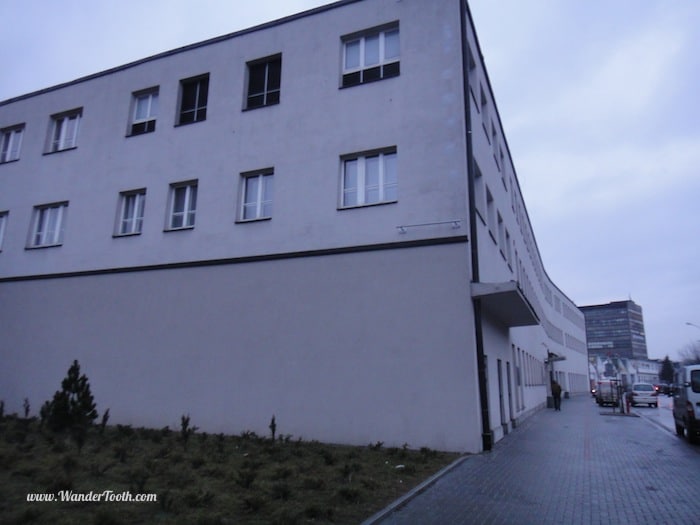
Once you get inside, however, the Schindler Factory does not disappoint, and you can expect a truly great museum experience.
For a Map and Atlas Nerd like myself (Did you know that I am a humongous M.A.A.N.?), gigantic photographs of what cities used to look like gets me really excited. I love old pictures of cities.
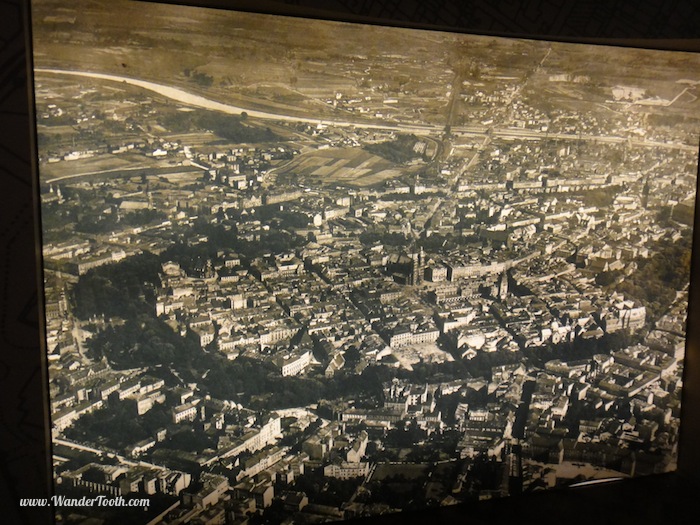
And the Schindler museum curators have done a wonderful job of telling the story of the daily misery Kraovians experienced, and the wide-ranging A-holery of the Nazis, through a combination of text, pictures, and artifacts.
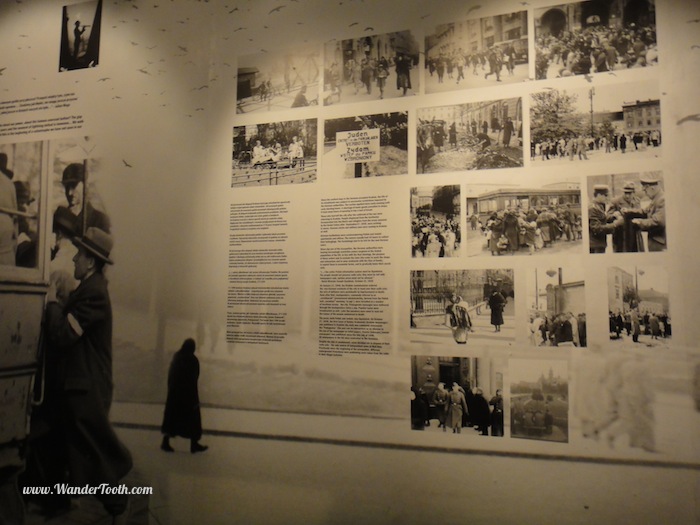
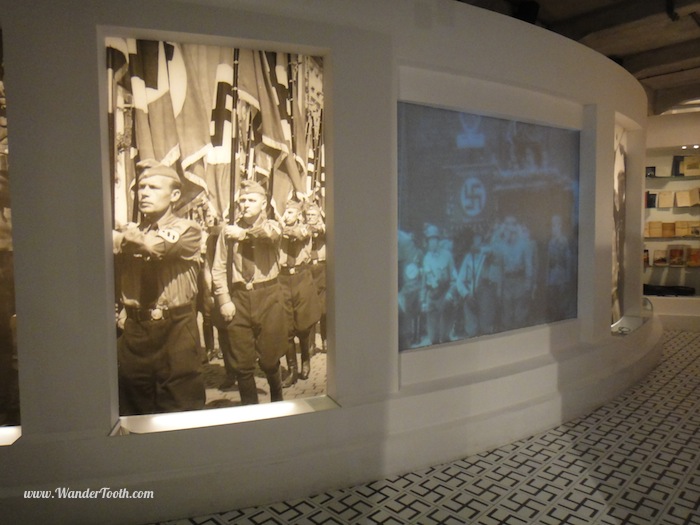
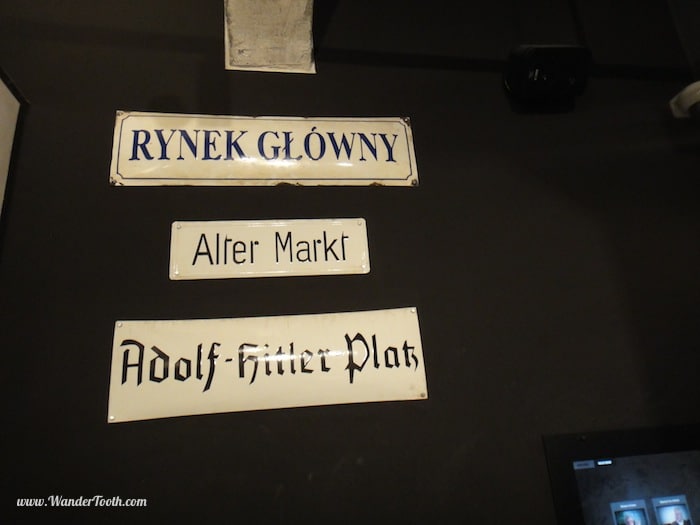
In addition to the photographs and artifacts, the Schindler Factory has a number of first hand accounts and statistics regarding the devastation wreaked by the Nazis, like these shocking statistics:
From 1939 to 1943, Krakow’s Jewish population shrunk from almost 70,000 to just under 9,000, not including those interred at prison camps; Krakow’s Jews were rationed only between 250 and 300 calories daily during the period.
One part of the Schindler museum made us both rather uncomfortable, and I didn’t really know how to react. I took a picture, but I felt really uncomfortable doing so. And it seemed to just beg insensitive tourists to act like A-holes — we actually saw two people doing a smiling self-portrait in front of these flags, and they didn’t seem to be neo-Nazis (no shaved heads or racially superior tattoos from what we could see).
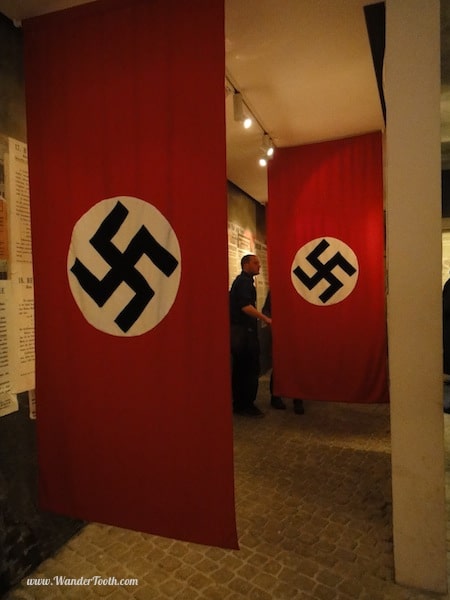
The Schindler Factory also does a good job at telling the story of Oskar Schindler himself, who started out as a miserly and opportunistic German business man. Schindler joined the Nazi party and went to Poland with the goal of profiting from the German invasion, and almost immediately gained control over an enamelware factory, complete with around 1,100 Jewish laborers to staff the thing. He seemed to be one of those slimy, profiteering bastards that thrives in wartime: as his factory made him more money, he started making friends with the top Nazi officials in Krakow, and then exploited those relationships to continue making as much money as he could. He was a wheeler and dealer of sorts.
At some point, the war changed the guy. Schindler witnessed a raid on the Krakow ghetto, during which everyone was either killed or rounded up and taken to concentration camps. From that point on, he began to use his extensive network of relationships with high ranking officials, special status of his factory, and seemingly endless stores of charm to protect those Jews who worked in his factory. He went bankrupt paying bribes, and relied more-or-less for the rest of his life on the financial help of Jewish organizations.
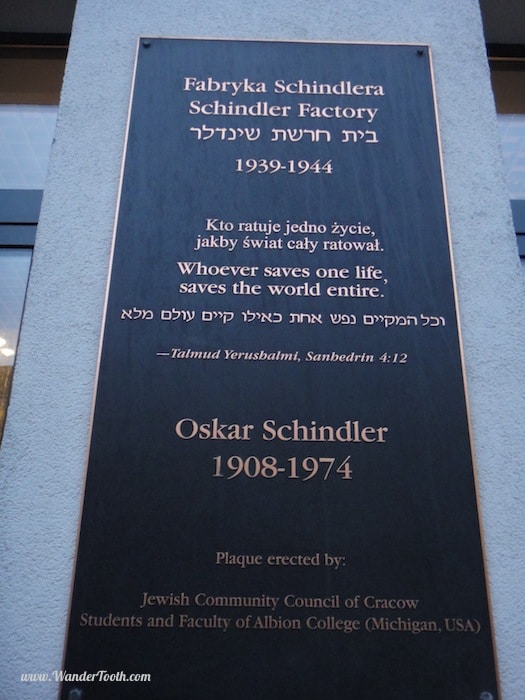
I should probably end this by saying I’m not trying to be glib about this time in history by calling them all A-holes, but the fact is, they were. The Nazis as a whole were some the biggest A-holes of all time, and Schindler — even though he ended up saving over a thousand people — was a complicated fellow, who started out as an A-hole, too. As for the non-Jewish Poles: many helped their Jewish neighbors, but many sold them out to the Nazis. A-holes.
If you decide to go, entry to the Schindler Factory is at Ul. Lipowa 4 and costs 15 zloties. Whatever you do, please don’t be an A-hole by taking a photo of your smiling self in front of the Nazi flags.

A lot of people did things during the war that they probably wouldn’t do at normal times, like giving up their neighbours. The more I learn about WWII and any war really, the more I learn about humans and the decisions they’ll make to guarantee their survival.
Taking a picture of your smiling self in front of a nazi flag in 2012, there’s no excuse for that.
Nat – you’re so right. People will do whatever they have to survive, I guess…it’s the people that are directing the war that are the real a-holes – everyone else are just casualties. When we were on the battle fields of WWI this winter, it really blew my mind. At least with WWII I can sort of “get” what the fight was about: stopping hitler. But with WWI it seems it was all about politics and spheres of influence. I just couldn’t wrap my head around it. We went to see the grave of Geoff’s great uncle, who died young and far away from home, and I just couldn’t really understand why he was even there in the first place. Which I guess is a comment on what an amazing life I’ve had the privilege of living — that I can’t understand war. Thanks for the comment and the support. Massive gratitude to you two!
I was about to write “I can’t believe that people took smiling pictures in front of Nazi flags”…but on second thought, I CAN totally believe it. I feel like people just don’t think things through sometimes. They smiled in a photo at the Eiffel Tower, they smiled in a photo at the Colosseum, so they smile in a photo at the Oskar Schindler Factory – it’s like an autopilot tourist-mode.
Jessica, I think you may be on to something. It was really weird to experience. We went to visit Auschwitch too, and thankfully did not see any misbehaving tourists there, but I’ve definitely witnessed it in other places, too. Thanks for your comment and support!
This is a wonderful A-Hole to Hero story Katie. The insight into the smiling flag snapping tourists needed to be shared. Good on you for saying it as it is. Great read.
Pingback: Visiting Auschwitz Museum - WanderTooth Travel Blog
Pingback: Cambodia's Killing Fields - Wandertooth Travel Blog